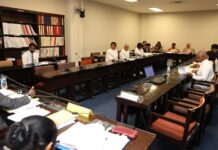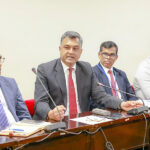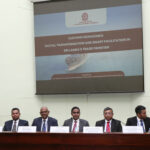The past few weeks have been a period of triumph and tribulation for Sri Lankans. On the one hand, the Covid pandemic continues to sweep the country taking more lives with it and the economy continues to take a hit as elsewhere in the world.
On the other hand, good news is also coming in for Sri Lanka from the arts and sports fields in the likes of singer Yohani and Javelin thrower Dinesh Priyantha Herath.
Amid these ups and downs, Sri Lanka’s future generation is facing a dire situation being confined to their homes with nothing much to do when online classes are halted as their teachers demand the Government to correct salary anomalies. While they try to teach the Government a lesson, their students have gone astray.
Ongoing strike
Holding children to ransom, teachers around the country threw caution to the wind to stage massive protests but later educated themselves enough of the rising Covid cases and deaths resulting from their blatant violation of Covid restrictions, and decided to halt gatherings.
However, millions of children are still left high and dry as online education has stopped altogether. Although tuition classes are in operation in urban areas, these are only for the affluent while the vast majority of children suffer without a proper education for the past few months and counting.
Although Government media channels have taken up the responsibility of education by airing relevant programs, this does not come close to the teacher-student interaction they had before.
Government school teachers withdrew from online teaching from July 12. Over 200,000 teachers have halted online teaching, responding to the call from the Ceylon Teachers Union (CTU), Ceylon Teacher Service Union, United Teachers Union and several other unions.
Kottu makers
It is true that teachers in Sri Lanka are in desperate need of a pay rise. Compared to other countries, school teachers have the backseat when it comes to salaries and privileges in the Government sector. Undoubtedly, this is of great concern especially when the future generation is in their hands.
Cabinet Spokesperson and Media Minister Dullas Alahapperuma also acknowledged this, stating that teachers’ salaries are below the wage of non-academic staff and kottu makers.
As a response, Education Minister Dinesh Gunawardena announced several measures to address teachers’ woes. This includes the implementation of salary increases in four stages and a Rs. 5,000 allowance for all teachers and principals for September and October in addition to their salary.
The Government has agreed to declare the teaching profession a closed service which was a demand by the trade unions. The salary increase is to be announced in the November budget.
However, some teachers disagree, saying this is a meagre amount. The Teachers and Principals’ Unions Alliance called on the Government to issue a circular and make the proposed increases in one payment, rather than in four instalments. However, it was reported that union leaders are ready to accept the Government offer, although there is pressure from within.
While the tug o’ war between teachers, union leaders and the Government continues, children are caught in the middle.
Policy
President Gotabaya Rajapaksa, in his ‘Vistas of Prosperity and Splendour’, has outlined several key areas where education can be uplifted. It includes the provision of opportunities for teachers to enhance their knowledge and climb up the ladder in their profession.
It states that an extra allowance will be paid to teachers who serve in schools in difficult and remote areas while opportunities will be provided to enter the Principal grade for teachers who possess the knowledge, skills, training and experience.
The manifesto gives hope for teachers as it also proposes to carry out administrative reforms not only for teachers that hold higher positions at schools but also for those showing their performance.
Most importantly, to address the question of gaining better qualifications and achieving a higher social standing, the manifesto promises to enable the teacher community to become qualified graduates by converting the 18 National Colleges of Education to university faculties.
Through this, teachers would gain better knowledge and skills to guide the future generation to compete in this globalised world. Needless to say, salaries should also be upped to attract the well-educated and keep them in the profession.
Reforms
However, most of these promises have not taken wing as the country is gripped by a pandemic.
Although it seems like all problems faced by the public these days are blamed on the pandemic, it is also true that patience needs to be practised in a situation where the country faces an unprecedented health and economic crisis.
The situation is faced not only by Sri Lanka, but also by the rest of the world. As such, the question is whether it is fair to hold the future generation to ransom by the very persons who have taken up the responsibility of educating them. On the other hand, a satisfied teacher would motivate children, enabling a better learning environment for them.
Examples from elsewhere in the world show that salary increases alone would not bring about gains in learning.
It is vital that they are coupled with other reforms such as ensuring higher standards in teaching and attracting professionals with better qualifications.
Along with salary increases, it is important to set higher standards and make the teaching profession more competitive that would ensure the best candidates are enrolled.
This is the strategy that countries such as Finland and Singapore, known for high performance on international tests, have adopted. In these countries, only a small number of applicants with excellent academic credentials gain entry into the teaching profession.
According to a World Bank study, many education systems are found to be stuck in a ‘low-learning trap’, described as low salaries, inadequate support and low standards in entry creating a less enabling learning environment.
Correcting these with a proper teacher training program would no doubt benefit our students to reach their full potential.
The President envisions these in his manifesto that clearly sets out strategies, and the future generation awaits the implementation of policies in full.










